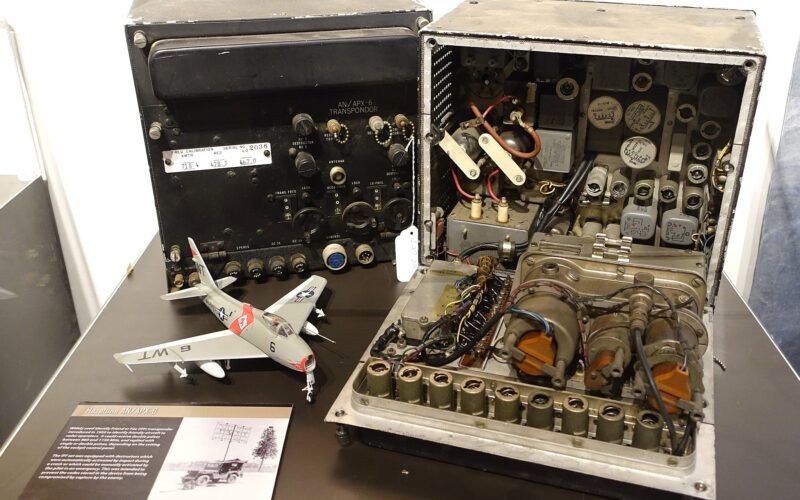What is a transponder?
A transponder is an electronic device found on aircraft that helps to identify them on air traffic control (ATC) radar screens. It is an essential component of the secondary surveillance radar system (SSR), without which the air traffic control radar beacon system cannot display secondary information.
Transponders allocate a unique transponder code to each aircraft in controlled airspace, enabling air traffic control officers to easily identify specific planes on a busy radar display using SSR.
The transponder gets radio signals from ground-based interrogators, which are radar beacon transmitter-receivers, and responds by producing a particular pulse or group of pulses that are only sent to the interrogators that match the transponder’s set mode.
Historical background
The history of transponders dates back to their initial use in military applications. Military authorities developed the concept of an Identification Friend or Foe (IFF) system, enabling them to identify friendly aircraft by transmitting a coded signal interrogated by military radar, helping with command and control missions.
These devices have become important tools for modern civilian aviation, allowing air traffic controllers to monitor and track aircraft movements more accurately and efficiently.
Transponder types
The different types of transponders are A, C, and S.
- Transponder A sends a code back to ATC.
- Transponder C sends a code and altitude information or flight level data to ATC.
- Transponder S sends code and altitude information while also receiving and reporting data to other S transponders.
All transponders must have the capability to generate a four-digit code using the numbers 1 to 7, which provides 4,096 possible codes.
Mode C transponders are required for flying in busy areas of controlled airspace, including entering class A airspace, flying within 30 nautical miles of primary airports in class B airspace, or flying in or above class C airspace.
In the entire continental United States, it is a requirement for all aircraft flying at or above 10,000 feet mean sea level (MSL), not including any airspace below 2,500 feet above ground level (AGL), to have Mode C transponders installed.
In accordance with Regulation (EU) No 1207/2011, all flights operating as general air traffic within the European Union and following instrument flight rules are mandated to be equipped with mode S transponders.
Ident features and regulations
Transponders have an “IDENT” feature that enables aircraft radar response to be easily distinguishable when the IDENT switch is triggered in the cockpit by the pilot. But this should only be done upon request by ATC. The IDENT feature allows the transponder to send a signal that causes it to flash on the radar screen.
Federal Aviation Administration (FAA) regulations mandate the testing of transponders every 24 calendar months for use in controlled airspace.
Each transponder has four fundamental functions: On, ALT, SBY, and Off.
- Turning the transponder on initiates the “On” function.
- The ability to transmit altitude information is activated through the “ALT” function.
- The “SBY” function is a mode on a transponder that turns off the transmission of information while still providing power to the unit.
- Turning the transponder off can be accomplished with the “Off” function.
The SQUAWK feature is the most fundamental function of a transponder, as it allows for the transmission of an encoded signal with a four-digit code. SQUAWK is given to the pilot by ATC when he contacts them for flight clearance.
Transponder codes for emergencies
The international agreement uses code 2000 for aircraft that have not received an assigned transponder code by ATC, though in some parts of Europe, 7000 is also used.
Other emergency codes include:
- 7500 for aircraft hijacking.
- 7600 for loss of communication (radio failure).
- 7700 for a general emergency.
- 1200 for aircraft flying visual flight rules (VFR).
These are international codes.
ACAS and safety
To prevent aircraft collisions, collision avoidance systems have been developed using transponder transmissions. These systems rely on transponder signals to identify aircraft on air traffic control radar and provide altitude information.
For the Airborne Collision Avoidance System (ACAS) to work, both the interrogator and target aircraft must have operating transponders. The type of information received by the ACAS depends on the type of transponder the target aircraft is equipped with.
Two types of alerts can be issued by an ACAS system: a Traffic Advisory (TA) and a Resolution Advisory (RA). The former alerts the pilot of a potential threat while the latter indicates the maneuver to follow back to safety. An aircraft equipped with a Mode ‘C’ or ‘S’ transponder can receive a TA and a RA while an aircraft with a Mode ‘A’ transponder will not be tracked by ACAS.
Learn more about aircraft transponders:

